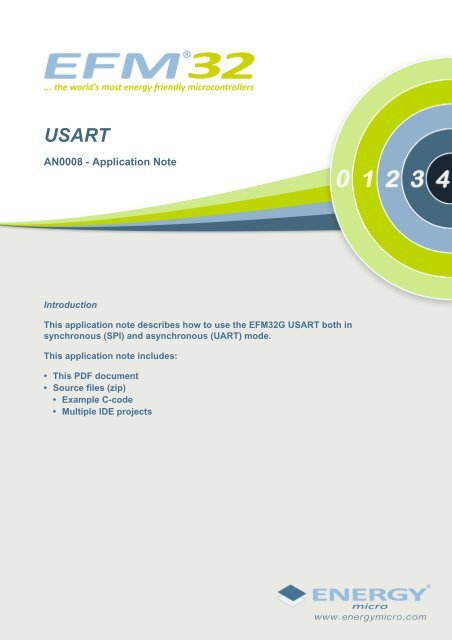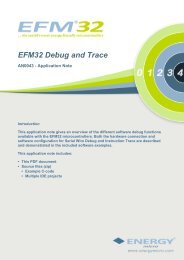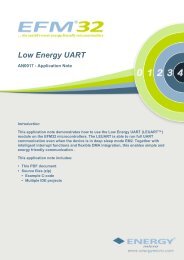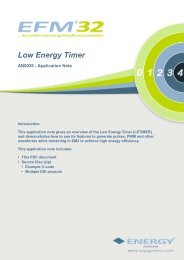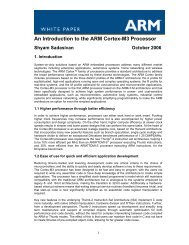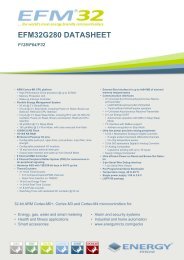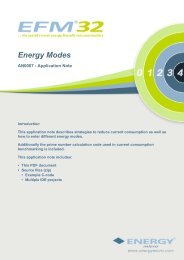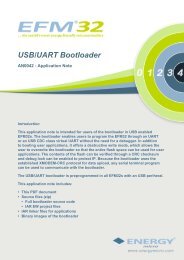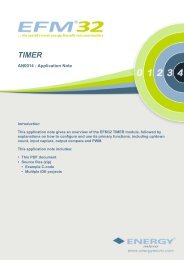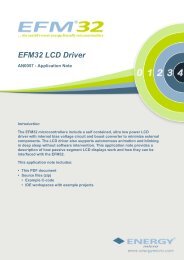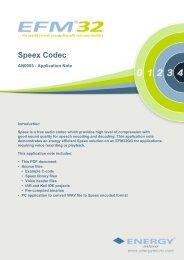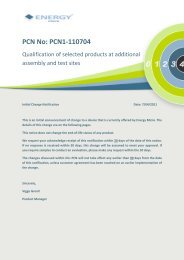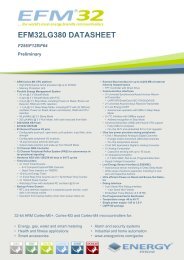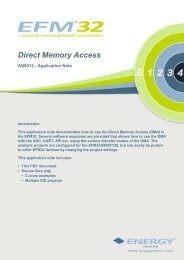USART - AN0008 - Application Note - Energy Micro
USART - AN0008 - Application Note - Energy Micro
USART - AN0008 - Application Note - Energy Micro
Create successful ePaper yourself
Turn your PDF publications into a flip-book with our unique Google optimized e-Paper software.
...the world's most energy friendly microcontrollers<br />
<strong>USART</strong><br />
<strong>AN0008</strong> - <strong>Application</strong> <strong>Note</strong><br />
Introduction<br />
This application note describes how to use the EFM32G <strong>USART</strong> both in<br />
synchronous (SPI) and asynchronous (UART) mode.<br />
This application note includes:<br />
• This PDF document<br />
• Source files (zip)<br />
• Example C-code<br />
• Multiple IDE projects
1 <strong>USART</strong><br />
...the world's most energy friendly microcontrollers<br />
1.1 Introduction<br />
The EFM32G Universal Synchronous Asynchronous serial Receiver and Transmitter (<strong>USART</strong>) is a very<br />
flexible serial communication module. It operates in either synchronous or asynchronous mode.<br />
In synchronous mode, a separate clock signal is transmitted with the data. This clock signal is generated<br />
by the bus master, and both the master and slave sample and transmit data according to this clock.<br />
Both master and slave modes are supported by the <strong>USART</strong>. The synchronous communication mode is<br />
compatible with the Serial Peripheral Interface Bus (SPI) standard.<br />
In asynchronous mode, no separate clock signal is transmitted with the data on the bus. The <strong>USART</strong><br />
receiver thus has to determine when to sample the data on the bus. To make this possible, additional<br />
synchronization bits are added to the data when operating in asynchronous mode, resulting in a slight<br />
overhead.<br />
1.2 Operation Overview<br />
An overview of the <strong>USART</strong> is shown in Figure 1.1 (p. 2) .<br />
Figure 1.1. <strong>USART</strong> Overview<br />
Peripheral Bus<br />
SS_n<br />
UART Control<br />
and status<br />
TX Buffer<br />
(2-level FIFO)<br />
RX Buffer<br />
(2-level FIFO)<br />
TX / MOSI<br />
TX Shift Register<br />
RX Shift Register<br />
SCLK<br />
Baud rate<br />
generator<br />
RX / MOSI<br />
Transmission is enabled by writing to the TXEN bit in the <strong>USART</strong>n_CMD register. Any data written to<br />
the TX buffer will be transmitted. The <strong>USART</strong> performs this by first moving the data to the shift register,<br />
from which the data is shifted to the TX pin. When data has been moved from the TX buffer, the TXBL<br />
bit in the <strong>USART</strong>n_STATUS register is set, indicating that a new transmit byte may be written. When all<br />
available transmit data (both in the shift register and in the TX buffer) have been transmitted, the TXC<br />
bit in the <strong>USART</strong>n_STATUS register is set. Both the TXC and TXBL are also available as interrupt flags.<br />
When the RXEN bit in the <strong>USART</strong>n_CMD register has been written, data received on the RX pin will be<br />
accepted. When new data is available from in the RX buffer, the RXDATAV bit in the <strong>USART</strong>n_STATUS<br />
register is set. This bit will be cleared when the RX buffer is read. The RXDATAV is also available as<br />
an interrupt.<br />
For a detailed description of the <strong>USART</strong> please refer to the EFM32G Reference Manual.<br />
2012-04-20 - an0008_Rev1.06 2 www.energymicro.com
2 Synchronous (SPI) Mode<br />
2.1 Theory<br />
...the world's most energy friendly microcontrollers<br />
The synchronous communication is normally set up using 4 lines; clock (SCLK), 2 data lines and slave<br />
select (SS_n, also known as chip select, CS), see Figure 2.1 (p. 3) . The data lines consist of MOSI<br />
(Master Out Slave In) and MISO (Master In Slave Out). These lines are driven by the master and the<br />
slave, respectively.<br />
Figure 2.1. Typical SPI Setup<br />
SCLK<br />
MOSI<br />
MISO<br />
SS_n<br />
SCLK<br />
MOSI<br />
MISO<br />
SS_n<br />
MASTER<br />
SLAVE<br />
A typical synchronous transaction is shown in Figure 2.2 (p. 3) . The master initiates the transfer by<br />
asserting the slave select line. Then the clock is driven by the master, and both master and slave shift<br />
data onto their data line while sampling the other (e.g. The slave drives the MISO line while listening to<br />
the MOSI line). This enables data transmission in both directions simultaneously. When the master has<br />
received/sent the desired data, it terminates the transaction by deasserting the SS_n line.<br />
Figure 2.2. Typical SPI Transaction<br />
SCLK<br />
MOSI X 0 1 2 3 4 5 6 7 X<br />
MISO X 0 1 2 3 4 5 6 7 X<br />
SS_n<br />
The polarity of the signals as well as the sampling instant may be changed. Please see the EFM32G<br />
Reference Manual for further details.<br />
2.2 SPI Example<br />
The attached SPI example illustrates the use of the <strong>USART</strong> in synchronous mode. <strong>USART</strong>1 is configured<br />
as slave, whereas <strong>USART</strong>2 is master. The following transactions take place:<br />
• Data transmission from master to slave.<br />
• Data transmission from slave to master.<br />
• Data transmission from master to slave and from slave to master simultaneously.<br />
In order to make the attached SPI example work as intended, the IO lines of <strong>USART</strong>1 and 2 must be<br />
connected as specified in Table 2.1 (p. 4) . If the EFM32G Development Kit (DVK) is used, these<br />
2012-04-20 - an0008_Rev1.06 3 www.energymicro.com
...the world's most energy friendly microcontrollers<br />
connections are easy to implement on the Prototyping Board. <strong>USART</strong>1 uses IO location 1 for its pins,<br />
whereas <strong>USART</strong>2 uses IO location 0.<br />
Table 2.1. SPI Connection Table<br />
Function <strong>USART</strong>1 #1 Protoboard Pin <strong>USART</strong>2 #0 Protoboard Pin<br />
MOSI PD0 P5.3 PC2 P4.5<br />
MISO PD1 P5.4 PC3 P4.6<br />
SCLK PD2 P5.5 PC4 P4.7<br />
SS_n PD3 P5.6 PC5 P4.8<br />
2012-04-20 - an0008_Rev1.06 4 www.energymicro.com
3 Asynchronous (UART) Mode<br />
3.1 Theory<br />
...the world's most energy friendly microcontrollers<br />
The asynchronous communication is normally set up using 2 data lines, one for transmission (TX) and<br />
one for reception (RX). The TX line of the first device is connected to the RX line of the second devices<br />
and vice versa, as seen in Figure 3.1 (p. 5) . Please note that there is no master and slave in terms<br />
of setup. However, a higher level protocol may implement such a relationship.<br />
Figure 3.1. Typical UART Setup<br />
TX<br />
RX<br />
RX<br />
TX<br />
UART1<br />
UART2<br />
The asynchronous operation differs from synchronous operation in that both units provide their own<br />
timing, i.e. there is no master clock determining sampling instants. Therefore, the transmission speed<br />
(baud rate) must be agreed upon prior to the transaction taking place. This can be done by convention<br />
or by detection. A typical asynchronous transfer is shown in Figure 3.2 (p. 5) .<br />
Figure 3.2. Typical UART Transaction<br />
Fram e<br />
Stop or idle<br />
Start or idle<br />
S 0 1 2 3 4 5 6 7 8 Stop<br />
A typical transfer is initiated by a start bit followed by 8 data bits and one or two stop bits to terminate<br />
the frame. Transmission of each frame is initiated at senders will. The number of data and stop bits<br />
may vary, and it is also possible to insert a parity bit for light error detection. Please see the EFM32G<br />
Reference Manual for further details on configuration possibilities.<br />
3.2 UART Example<br />
The attached UART example illustrates the use of the <strong>USART</strong> in asynchronous mode. Both <strong>USART</strong>1<br />
and <strong>USART</strong>2 are configured to use a baud rate of 115200, 8 data bits, no parity bit and one stop bit. The<br />
High Frequency Crystal Oscillator (HFXO) is used to increase the absolute accuracy of the baudrate.<br />
The following transactions are added:<br />
• <strong>USART</strong>2 transfers data using polling. <strong>USART</strong>1 receives using interrupt.<br />
• <strong>USART</strong>2 transfers data using interrupt. <strong>USART</strong>1 receives using polling.<br />
In order to make the attached UART example work as intended, the IO lines of <strong>USART</strong>1 and 2 must be<br />
connected as specified in Table 3.1 (p. 5) . If the EFM32G Development Kit (DVK) is used, these<br />
connections are easy to implement on the Prototyping Board.<br />
Table 3.1. UART Connection Table<br />
Direction <strong>USART</strong>1 #1 Protoboard Pin <strong>USART</strong>2 #0 Protoboard Pin<br />
1 -> 2 PD0 P5.3 PC3 P4.6<br />
2 -> 1 PD1 P5.4 PC2 P4.5<br />
2012-04-20 - an0008_Rev1.06 5 www.energymicro.com
4 Revision History<br />
...the world's most energy friendly microcontrollers<br />
4.1 Revision 1.06<br />
2012-04-20<br />
Adapted software projects to new peripheral library naming and CMSIS_V3.<br />
Fixed a pin configuration issue with the uart example.<br />
4.2 Revision 1.05<br />
2012-03-14<br />
Removed AF-Pin definitions from code example.<br />
Fixed makefile-error for CodeSourcery projects.<br />
4.3 Revision 1.04<br />
2011-08-19<br />
Corrected GPIO configuration for SPI slave.<br />
4.4 Revision 1.03<br />
2011-03-24<br />
Changed the location description for <strong>USART</strong>1.<br />
4.5 Revision 1.02<br />
February 1st, 2011.<br />
Changed GPIO configuration to reduce code size.<br />
4.6 Revision 1.01<br />
November 16th, 2010.<br />
Changed example folder structure, removed build and src folders.<br />
Added chip-init function.<br />
Small code changes in spi.c<br />
4.7 Revision 1.00<br />
September 20th, 2010.<br />
Initial revision.<br />
2012-04-20 - an0008_Rev1.06 6 www.energymicro.com
A Disclaimer and Trademarks<br />
A.1 Disclaimer<br />
...the world's most energy friendly microcontrollers<br />
<strong>Energy</strong> <strong>Micro</strong> AS intends to provide customers with the latest, accurate, and in-depth documentation<br />
of all peripherals and modules available for system and software implementers using or intending to<br />
use the <strong>Energy</strong> <strong>Micro</strong> products. Characterization data, available modules and peripherals, memory<br />
sizes and memory addresses refer to each specific device, and "Typical" parameters provided can and<br />
do vary in different applications. <strong>Application</strong> examples described herein are for illustrative purposes<br />
only. <strong>Energy</strong> <strong>Micro</strong> reserves the right to make changes without further notice and limitation to product<br />
information, specifications, and descriptions herein, and does not give warranties as to the accuracy<br />
or completeness of the included information. <strong>Energy</strong> <strong>Micro</strong> shall have no liability for the consequences<br />
of use of the information supplied herein. This document does not imply or express copyright licenses<br />
granted hereunder to design or fabricate any integrated circuits. The products must not be used within<br />
any Life Support System without the specific written consent of <strong>Energy</strong> <strong>Micro</strong>. A "Life Support System"<br />
is any product or system intended to support or sustain life and/or health, which, if it fails, can be<br />
reasonably expected to result in significant personal injury or death. <strong>Energy</strong> <strong>Micro</strong> products are generally<br />
not intended for military applications. <strong>Energy</strong> <strong>Micro</strong> products shall under no circumstances be used in<br />
weapons of mass destruction including (but not limited to) nuclear, biological or chemical weapons, or<br />
missiles capable of delivering such weapons.<br />
A.2 Trademark Information<br />
<strong>Energy</strong> <strong>Micro</strong>, EFM32, EFR, logo and combinations thereof, and others are the registered trademarks or<br />
trademarks of <strong>Energy</strong> <strong>Micro</strong> AS. ARM, CORTEX, THUMB are the registered trademarks of ARM Limited.<br />
Other terms and product names may be trademarks of others.<br />
2012-04-20 - an0008_Rev1.06 7 www.energymicro.com
B Contact Information<br />
...the world's most energy friendly microcontrollers<br />
B.1 <strong>Energy</strong> <strong>Micro</strong> Corporate Headquarters<br />
Postal Address Visitor Address Technical Support<br />
<strong>Energy</strong> <strong>Micro</strong> AS<br />
P.O. Box 4633 Nydalen<br />
N-0405 Oslo<br />
NORWAY<br />
www.energymicro.com<br />
Phone: +47 23 00 98 00<br />
Fax: + 47 23 00 98 01<br />
B.2 Global Contacts<br />
<strong>Energy</strong> <strong>Micro</strong> AS<br />
Sandakerveien 118<br />
N-0484 Oslo<br />
NORWAY<br />
support.energymicro.com<br />
Phone: +47 40 10 03 01<br />
Visit www.energymicro.com for information on global distributors and representatives or contact<br />
sales@energymicro.com for additional information.<br />
Americas Europe, Middle East and Africa Asia and Pacific<br />
www.energymicro.com/americas www.energymicro.com/emea www.energymicro.com/asia<br />
2012-04-20 - an0008_Rev1.06 8 www.energymicro.com
...the world's most energy friendly microcontrollers<br />
Table of Contents<br />
1. <strong>USART</strong> .................................................................................................................................................... 2<br />
1.1. Introduction .................................................................................................................................... 2<br />
1.2. Operation Overview ......................................................................................................................... 2<br />
2. Synchronous (SPI) Mode ............................................................................................................................ 3<br />
2.1. Theory .......................................................................................................................................... 3<br />
2.2. SPI Example .................................................................................................................................. 3<br />
3. Asynchronous (UART) Mode ....................................................................................................................... 5<br />
3.1. Theory .......................................................................................................................................... 5<br />
3.2. UART Example .............................................................................................................................. 5<br />
4. Revision History ........................................................................................................................................ 6<br />
4.1. Revision 1.06 ................................................................................................................................. 6<br />
4.2. Revision 1.05 ................................................................................................................................. 6<br />
4.3. Revision 1.04 ................................................................................................................................. 6<br />
4.4. Revision 1.03 ................................................................................................................................. 6<br />
4.5. Revision 1.02 ................................................................................................................................. 6<br />
4.6. Revision 1.01 ................................................................................................................................. 6<br />
4.7. Revision 1.00 ................................................................................................................................. 6<br />
A. Disclaimer and Trademarks ........................................................................................................................ 7<br />
A.1. Disclaimer ..................................................................................................................................... 7<br />
A.2. Trademark Information .................................................................................................................... 7<br />
B. Contact Information ................................................................................................................................... 8<br />
B.1. <strong>Energy</strong> <strong>Micro</strong> Corporate Headquarters ................................................................................................ 8<br />
B.2. Global Contacts ............................................................................................................................. 8<br />
2012-04-20 - an0008_Rev1.06 9 www.energymicro.com
...the world's most energy friendly microcontrollers<br />
List of Figures<br />
1.1. <strong>USART</strong> Overview .................................................................................................................................... 2<br />
2.1. Typical SPI Setup ................................................................................................................................... 3<br />
2.2. Typical SPI Transaction ........................................................................................................................... 3<br />
3.1. Typical UART Setup ................................................................................................................................ 5<br />
3.2. Typical UART Transaction ........................................................................................................................ 5<br />
2012-04-20 - an0008_Rev1.06 10 www.energymicro.com
...the world's most energy friendly microcontrollers<br />
List of Tables<br />
2.1. SPI Connection Table .............................................................................................................................. 4<br />
3.1. UART Connection Table .......................................................................................................................... 5<br />
2012-04-20 - an0008_Rev1.06 11 www.energymicro.com


